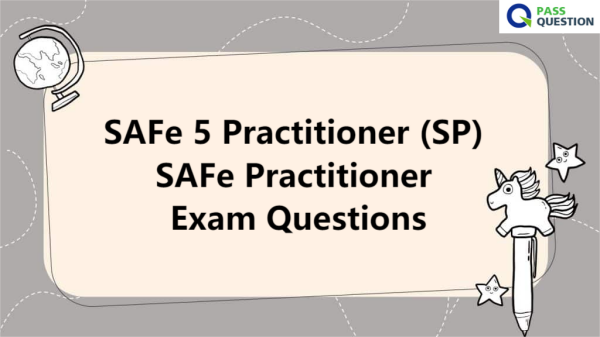SAFe 5 Practitioner (SP) SAFe Practitioner Exam Questions
Preparing for SP - SAFe Practitioner exam? The SAFe 5 Practitioner (SP) certification exam evaluates a candidate's skills and understanding. PassQuestion provides the latest SAFe 5 Practitioner (SP) SAFe Practitioner Exam Questions so you can pass SP - SAFe Practitioner exam on the first attempt. We are offering the best SAFe 5 Practitioner (SP) SAFe Practitioner Exam Questions that you can use to prepare for the real exam. We highly recommend you to go through all of the SAFe 5 Practitioner (SP) SAFe Practitioner Exam Questions so you can easily get the best results. Make sure that you are using all of our SAFe 5 Practitioner (SP) SAFe Practitioner Exam Questions to ensure your success in the real exam.

SP - SAFe Practitioner
A Certified SAFe 5 Practitioner (SP) is a SAFe team member professional responsible for using Scrum, Kanban, and XP in a SAFe environment. Key areas of responsibility include planning Program Increments and iterations, breaking requirements into stories, developing incrementally with built-in quality, demoing value at a team and program level, and problem solving impediments to drive relentless improvement.
Exam Information
Duration: 90 minutes
Number of questions: 45
Passing score: 35/45 (77%)
Competency level: Intermediate; Proficient, capable; can perform tasks with some assistance
Question format: Multiple choice (one answer) or multiple select (2-3 answers)
Delivery: Web-based, closed book, no outside assistance, timed
Languages offered: English, Japanese (5.1.1), Simplified Chinese (5.1.1)
Cost: First attempt included in the course registration fee if taken within 30 days of course completion. Each retake or attempt past the 30-day window is $50
Exam Sections and Percentages
Introducing SAFe (20%)
- Connect with SAFe and the SAFe Configurations
- Explore Lean, the Agile Manifesto, and SAFe Principles
- Identify Scrum, Kanban and Extreme Programming (XP) Practices
Building an Agile team (18%)
- Build Your Team
- Explore the Scrum Master and Product Owner roles
- Meet the Teams and People on the Agile Release Train
Planning the Iteration (18%)
- Prepare the Backlog
- Plan the Iteration: Purpose, Process, Result, Commitment
Executing the Iteration (24%)
- Visualize the Flow of Work
- Measure the Flow of Work
- Build Quality In
- Continuously Integrate, Deploy, and Release
- Control Flow with Meetings
- Demo Value
- Retrospect and Improve
Executing the PI (20%)
- Plan Together
- Integrate and Demonstrate Together
- Learn Together
View Online SAFe 5 Practitioner (SP) SAFe Practitioner Free Questions
1. Which of the below are not part of the CALMR approach to DevOps?
A. Culture
B. Automation
C. Large batches
D. Measurement
Answer: C
2. Which component of the Continuous Delivery Pipeline focuses on creating alignment on what needs tobe built?
A. Continuous Deployment
B. Continuous Exploration
C. Release On Demand
D. Continuous Integration
Answer: B
3. What event helps the team think about new stories prior to Iteration Planning
A. Daily standup
B. Backlog Refinement Session
C. Iteration Retrospective
D. Iteration Review
Answer: B
4. Which of the following are roles at the ART level?
A. Business Owners
B. ProductOwner
C. System Architect
D. System Team
Answer: A, C, D
5. What team level event hasitsfocus mostly on the next Iteration, but it allows time to discuss future Iterations and even Features for the next Pl?
A. Iteration Review
B. Iteration Retrospective
C. Backlog Refinement Session
D. Daily standup
Answer: C
- TOP 50 Exam Questions
-
Exam
All copyrights reserved 2025 PassQuestion NETWORK CO.,LIMITED. All Rights Reserved.

